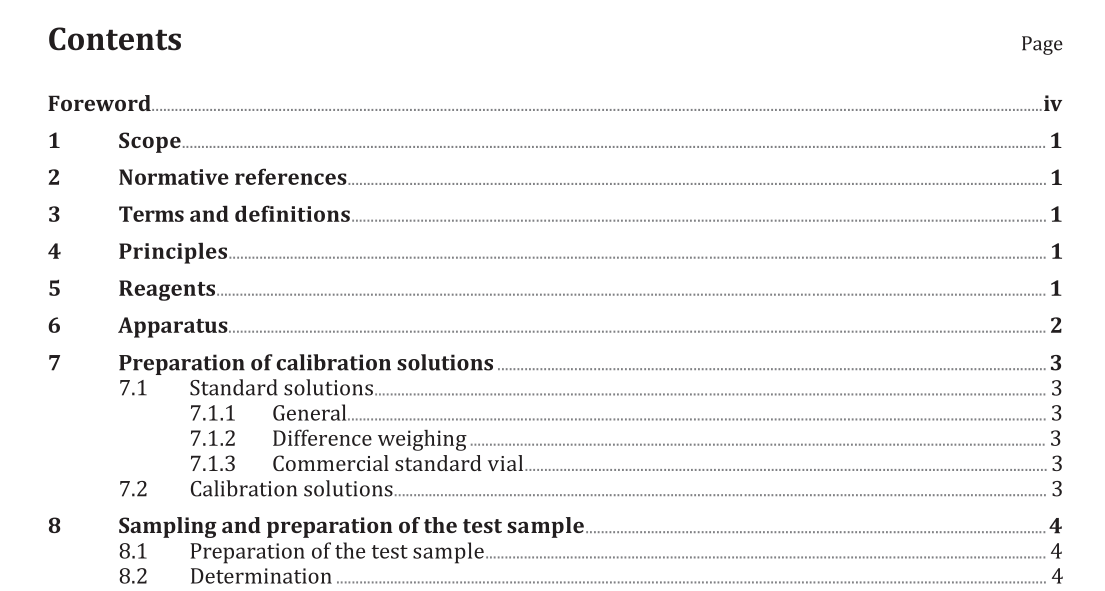BS ISO 19619:2018 pdf download.Surface active agents — Determination of free propylene oxide content in propylene oxide adduct surfactants — GC method
1 Scope
This document specifies an analytical procedure for the determination of free propylene oxide in surfactants which are synthesized from propylene oxide copolymers.
The method is appropriate for the qualitative and quantitative determination of propylene oxide groups in propylene oxide adducts, polyethers and polyglycol esters by headspace gas chromatography (HS-GC) with a flame ionization detector (FID) based on external procedure. Gas chromatography-mass spectrometry (GC-MS) is used for the confirmatory purposes.
2 Normative references
The following documents are referred to in the text in such a way that some or all of their content constitutes requirements of this document. For dated references, only the edition cited applies. For undated references, the latest edition of the referenced document (including any amendments) applies.
ISO 607, Surface active agents and detergents — Methods of sample division
ISO 3696, Water for analytical laboratory use — Specification and test methods
3 Terms and definitions
No terms and definitions are listed in this document.
ISO and IEC maintain terminological databases for use in standardization at the following addresses:
— ISO Online browsing platform: available at https://www.iso.org/obp
— IEC Electropedia: available at http://www.electropedia.org/
4 Principles
The sample is weighed into a headspace vial and the sealed vial is placed in a head space sampling instrument and allowed to reach thermal equilibrium. A portion of the vapour phase is then analysed by temperature programmed gas chromatography (GC). Qualitative detection is determined by retention time of target compounds with FID or by relative abundance ratios of the fragment ions with MSD.
Quantification is achieved by external quantification method for GC-FID.
5 Reagents
During the analysis, use only reagents of recognized analytical grade.
7 Preparation of calibration solutions
7.1 Standard solutions
7.1.1 General Prepare the working solution of propylene oxide either by difference weighing or using a commercial standard vial.
7.1.2 Difference weighing
Weigh a 50 ml volumetric flask containing approx. 40 ml of DMAC (5.3). Add ~50 mg propylene oxide (5.2 a) into the flask and reweigh with a cooled syringe. Fill the flask to the mark with DMAC and mix carefully. By weighing the difference, calculate the actual concentration in mg propylene oxide/ml solution precisely.
7.1.3 Commercial standard vial
Prepare appropriate concentrations of standard solution by multistage dilutions with DMAC (5.3) from the certified propylene oxide stock solutions (5.2 b), that may be purchased from commercial suppliers. Stored solution in a refrigerator at 4 °C for about 4 weeks.
7.2 Calibration solutions
Prepare the calibration solution as follows: Add about 8 ml DMAC (5.3) each into seven 10 ml volumetric flasks (6.8). Using a micropipette or micro syringe (6.9), pass a certain amount of propylene oxide working solution (see 7.1) into the volumetric flasks according to Table 1. Make up to volume with DMAC and follow by vortex and oscillation, so that each calibration solution contains 0 μg; 2,5 μg; 5,0 μg; 10,0 μg; 12,5 μg; 25,0 μg; 50,0 μg and 100,0 μg of propylene oxide respectively.
BS ISO 19619:2018 pdf download
